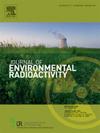利用铀矿废石筑路材料的放射性考虑。
IF 1.9
3区 环境科学与生态学
Q3 ENVIRONMENTAL SCIENCES
引用次数: 0
摘要
印度的道路建设对其基础设施的发展至关重要,每公里需要大约2万吨高质量的骨料,而这种材料越来越稀缺,导致成本上升和延误。作为印度经济基石的工业部门也在努力解决废物管理问题。早期的研究表明,工业废物可以用于道路建筑材料,但辐射方面的考虑并不集中。探讨了利用铀矿废石作为道路建筑材料的潜力。在印度铀矿开采的早期阶段,产生了数百万吨的废石,通常被丢弃,需要大片土地和昂贵的管理。在本研究中,我们评估了使用废石作为贫铀矿石产生的道路建筑材料的放射性考虑因素。为此,采用了印度典型的分层道路设计,并通过QAD-CGGP代码计算和实际测量来评估剂量率。结果表明,在道路建筑材料中使用废石对公众的外辐射剂量保持在1 mSv/年以下。观察剂量率符合国家监管机构规定;原子能管理委员会在公共领域不受限制地使用散装材料的标准为1毫西弗/年。这种方法不仅解决了资源短缺问题,而且通过保护自然资源、减少生态失衡和促进循环经济来支持环境的可持续性。本文章由计算机程序翻译,如有差异,请以英文原文为准。

Radiological considerations in using uranium mine waste rock for road construction materials
India's road construction is vital for its infrastructure growth, requiring approximately 20,000 tons of high-quality aggregates per kilometer - materials that are increasingly scarce, leading to higher costs and delays. The industrial sector, a cornerstone of the Indian economy, also struggles with waste management. Earlier studies suggested that industrial waste can be used in road construction materials however, the radiological considerations were not focused. This paper explores the potential of utilizing uranium mine waste rock in road construction materials. In the early stages of uranium mining in India, millions of tons of waste rock are generated and typically discarded, requiring extensive land and costly management. In this study, we assessed the radiological considerations in using waste rocks as road construction material generated from lean uranium ore. For this, a typical layered road design in India is adopted and dose rate were evaluated by QAD-CGGP code calculations and real-world measurements. Results indicate that the external radiation dose by using these waste rock in road construction materials remains below 1 mSv/year for the public. The observed dose rate complies the National regulatory agency; Atomic Energy Regulatory Board criteria of 1 mSv/y for the unrestricted use of bulk materials in public domain. This approach not only addresses resource scarcity but also supports environmental sustainability by conserving natural resources, reducing ecological imbalances, and promoting a circular economy.
求助全文
通过发布文献求助,成功后即可免费获取论文全文。
去求助
来源期刊

Journal of environmental radioactivity
环境科学-环境科学
CiteScore
4.70
自引率
13.00%
发文量
209
审稿时长
73 days
期刊介绍:
The Journal of Environmental Radioactivity provides a coherent international forum for publication of original research or review papers on any aspect of the occurrence of radioactivity in natural systems.
Relevant subject areas range from applications of environmental radionuclides as mechanistic or timescale tracers of natural processes to assessments of the radioecological or radiological effects of ambient radioactivity. Papers deal with naturally occurring nuclides or with those created and released by man through nuclear weapons manufacture and testing, energy production, fuel-cycle technology, etc. Reports on radioactivity in the oceans, sediments, rivers, lakes, groundwaters, soils, atmosphere and all divisions of the biosphere are welcomed, but these should not simply be of a monitoring nature unless the data are particularly innovative.
 求助内容:
求助内容: 应助结果提醒方式:
应助结果提醒方式:


